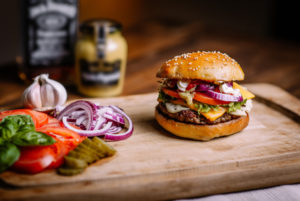 The Internet offers a lot in terms of marketing, letting small food businesses compete with the big guys, and reaching new audiences around the world. But there’s a huge disadvantage in not being to let your visitors actually taste your food! So how to communicate how juicy that burger is?
The Internet offers a lot in terms of marketing, letting small food businesses compete with the big guys, and reaching new audiences around the world. But there’s a huge disadvantage in not being to let your visitors actually taste your food! So how to communicate how juicy that burger is?
Well, first of all, take advantage of your photography. In our photo, the choice for the rustic tray sets a tone for the food that would be completely different if the burger was served on bright white china or Fiestaware.
Second, use tasty words to describe your offerings. If you’re adding onions, make them “fresh, crisp red onions.” Tomatoes can be “fresh-off-the-vine red Roma tomatoes.” Are the hamburger buns home-made? Do they come from a local vendor? What about the cheese? What’s special about it and is it nicely melted on the burger? The more details you can give, the better. Especially if you have a locavore focus, talk about the vendors whose products you feature.
Adjectives are our friend. Use appetizing words – look at what these words evoke as you read them: hearty, zesty, gooey, drenched, spicy, robust, creamy, chilled, rich, aromatic, lush, savory. Hungry yet? Of course, you have to use words that are applicable. If your onions aren’t crunchy consistently, don’t say so. You have to be able to deliver what you’re promising with all those words and photos.
These techniques also help you differentiate yourself in the marketplace; it’s good for your food marketing! Because even as you’re describing what you’re offering, remember that you’re still marketing. The best of stories need to be told with an eye towards stating what makes your burger different (and tastier) from the one down the street. The better you know your audience, the more you’ll know what words to choose to reach them!
So what can you do to make your online food stories tasty?
I find it fascinating that food reflects unique aspects of a particular culture. And what story can be more interesting than one that incorporates all the senses as only a uniquely prepared dish can?